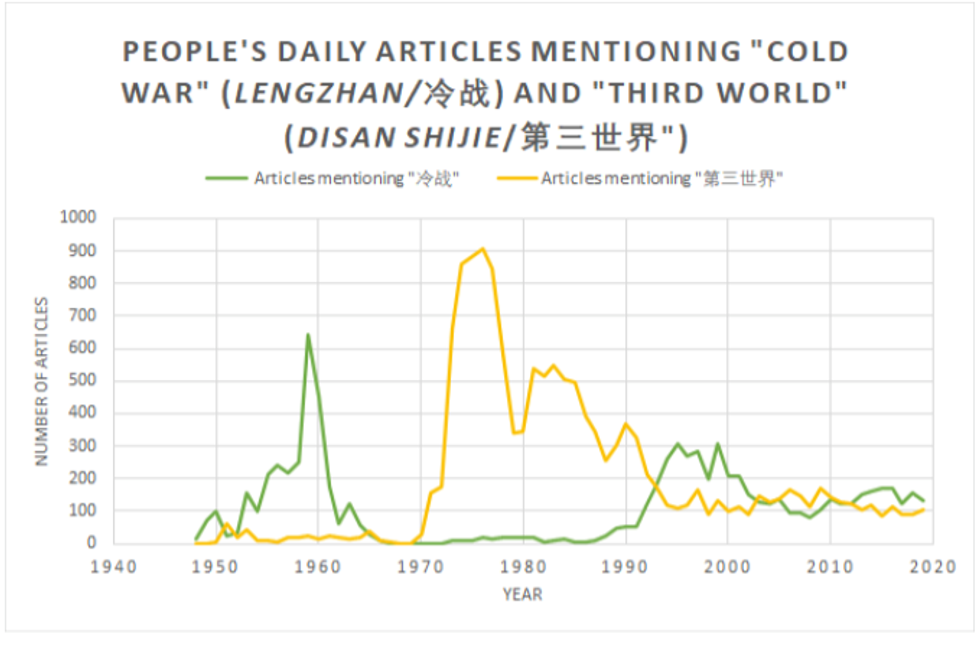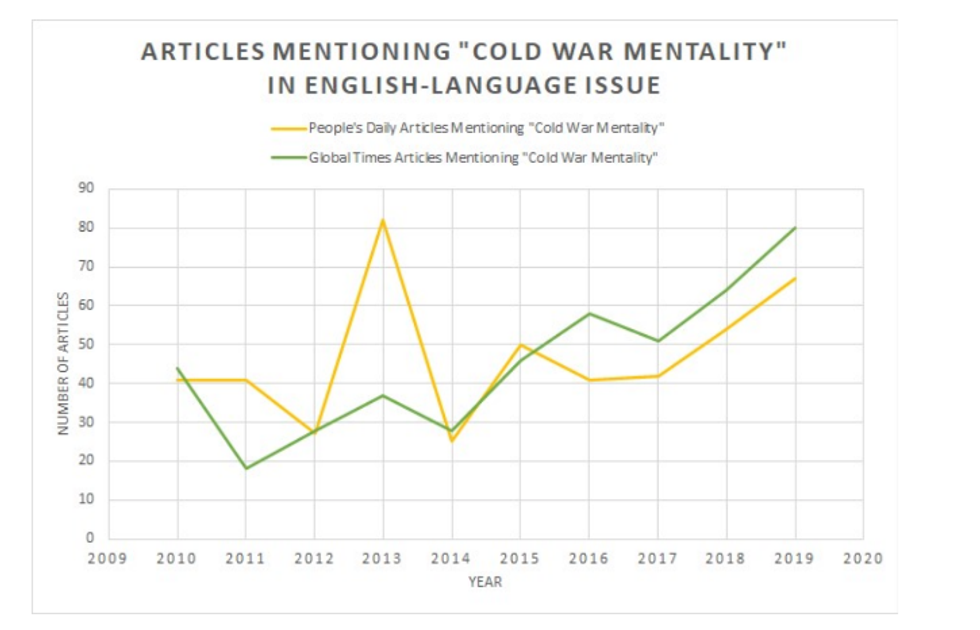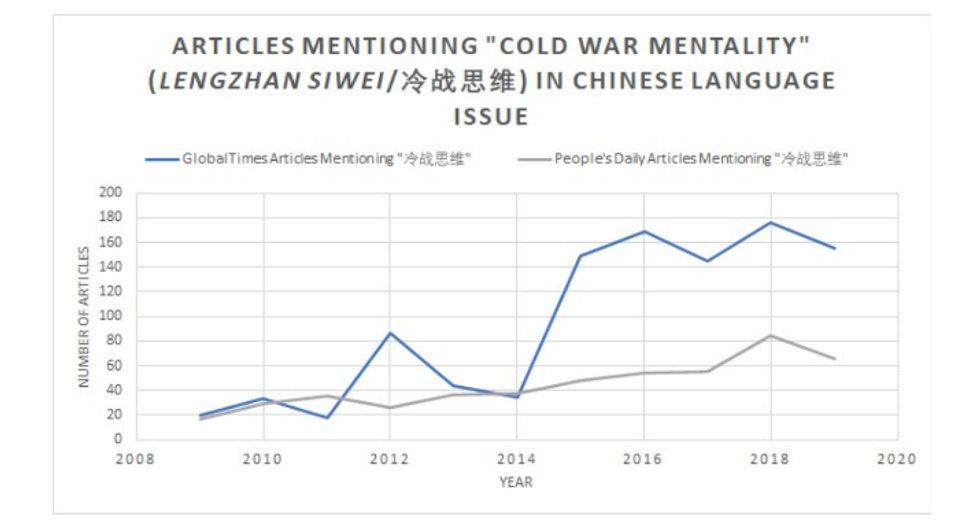“Is the U.S. dragging China and the U.S. into a ‘new Cold War’?” This was the question posed by the Global Times, a popular Chinese Communist Party newspaper with a commercial, nationalist orientation. On August 12, the Global Times released an interview on the subject with Le Yucheng, China’s Vice Minister of Foreign Affairs. The piece is one of more than 60 similar interviews and op-eds that the paper has published so far this year.
But the Global Times is hardly alone in its concern: virtually every major American news outlet has now run stories about the prospect of a “cold war” between the United States and China, from The New York Times to Foreign Policy. The biggest difference? To American publications, concerns over a new cold war are novel, whereas Chinese media outlets have long expressed anxiety about the risks of getting caught up in a new cold war, especially with the United States, and have used such concerns to criticize U.S. policies perceived as hostile. Understanding this phenomenon is vitally important for American policymakers who wish to avoid inadvertently inflaming tensions with China further.
To illustrate the durability of the “cold war” framework in Chinese media, and how it is used, let us first examine the archives of the People’s Daily, the main official newspaper of the Chinese Communist Party.
The People’s Daily has been writing about the “new cold war” for years. One may be surprised to learn that the People’s Daily actually used the Mandarin words for “cold war” much more frequently in the 1990s and 2000s, after the original Cold War concluded, than it did prior to the collapse of the Soviet Union. Below is a graph of the term’s usage across the archives:
The first spike of cold war mentions corresponds to the beginning of the Cold War and the U.S.-USSR arms race. Articles from this time period tend to focus on that conflict and sympathize with the Soviet Union. In the early 1960s, however, use of the term drops off. This corresponds roughly to the Sino-Soviet split.
In its place, Mao Zedong formulated China’s own version of the “three worlds” paradigm, with the U.S. and USSR as the “first world,” wealthy countries like the U.K. and Japan as the “second world,” and China as the vanguard of the developing “third world,” concentrated in Africa, South America, and Asia.
Then in the 1990s, as the Cold War ended, there was a resurgence of “cold war” talk, accompanied by a decline in references to the Third World. Articles using the “cold war” terminology from about 2000 onward use it to criticize the approach to China taken by other countries — usually the U.S., but also frequently Japan, South Korea, and India — as unnecessarily hostile and zero-sum.
There is some evidence that the criticism and concern about this approach is growing in China. Searches for “Cold War mentality” in English and Chinese across the archives of the People’s Daily and the Global Times yield some interesting data.
________



First, in results from the Chinese-language version of the search, there has been an increase in references to 冷战思维 (lengzhan siwei, or “Cold War mentality”) in both publications. However, while this increase has been gradual in the case of the People’s Daily, there was a starker increase in such references in the Global Times in 2015, as tensions between the U.S. and China began to increase during the Obama administration:
By contrast, results from the English-language versions are fairly static, though they seem to begin trending slightly upward in recent years, at least in the Global Times:
While both graphs that use of the term is increasing, the increase is greater in the Chinese-language versions of the papers, especially the Global Times. This suggests that “Cold War mentality” is being used as part of a nationalist narrative about American aggression. This is especially the case for the Global Times, which has a strong nationalist bent. However, both papers have used this terminology less in their foreign-oritented versions, which are more diplomatic and less nationalist in tone. Furthermore, the content of the articles, similar to those from 2000 onward in the first graph, is focused on criticizing the hostile foreign policy of other countries, not on self-criticism and internal debate, as is often the case in the U.S.
What does all this mean for U.S. foreign policy going forward? It is clear that there are multiple frameworks in use by Chinese sources to describe American behavior: “cold war” and the “third world” are two major ones, and there are almost certainly others. References to “Cold War mentality” seem to be used primarily to criticize threatening and zero-sum behavior by the U.S. and its allies, building wariness of such behavior and public support for Chinese policies at home.
It is ironic that criticisms of current American foregn policy as risking or engaging in a “new cold war” or having a “cold war mentality” sound so similar to decades-old Chinese nationalist propaganda--propaganda which itself could create the hostile and zero-sum mentality it castigates. But it would be a mistake to discourage discussion of America’s China policy, or criticism of the U.S. government, just because the Chinese Communist Party is saying it too. Whether or not one agrees with the media’s criticism of the current policy approach, America’s free press is actually a foreign policy asset. It gives foreign observers more accurate information about whether a policy has broad public support, and thus whether it will survive successive Presidential administrations and iterations of Congress. This can calm tensions and prevent foreign governments from overreacting. Some of the same pieces from the Global Times and People’s Daily cited above are evidence of this; they continuously call on the U.S. to change course, which means their authors and publishers must believe that change is still possible.
The Chinese people lack the right of free speech, and they also lack a platform they can use to vigorously debate their government’s foreign policy. One result is that foreign observers mistakenly assume unanimous support for the Chinese government’s more hawkish policies, which can make China itself seem more threatening than it actually is. Perhaps watching the “new cold war” debate in the U.S. unfold will help the Chinese people see the value of free expression to good government. But until then, Americans should remember that cold war terminology does not mean the same thing in China that it does here. Hopefully, keeping this context in mind will help prevent American observers from overreacting to CCP bluster and making this “cold war” language a reality.














